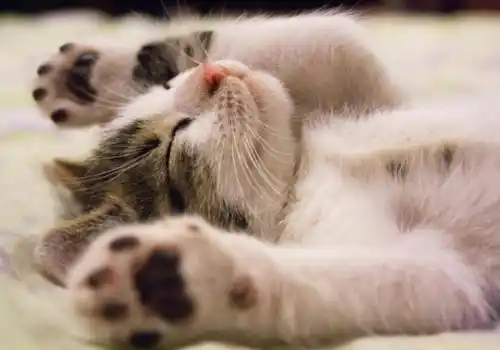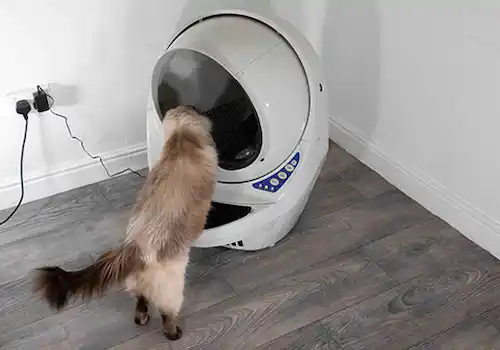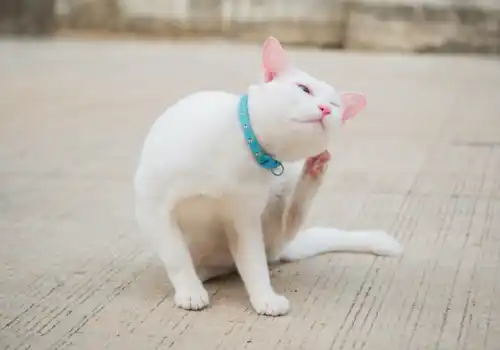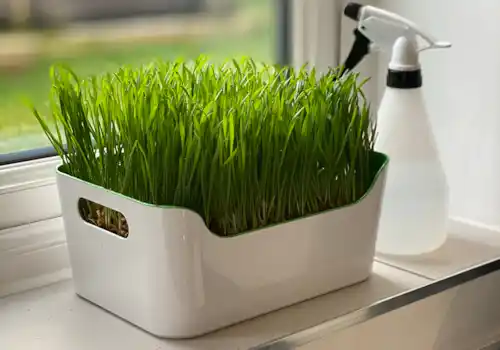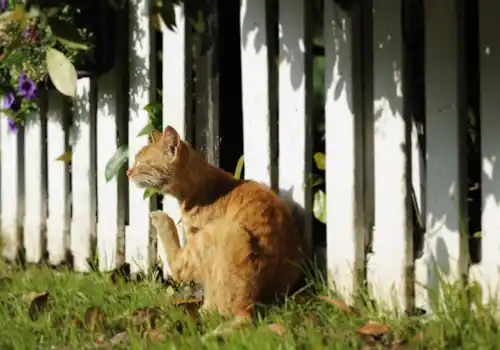How can you help a cat who suffers from diabetes? Here's a round-up of the signs, symptoms and treatments available.
Diabetes mellitus is most common in older cats. Neutered cats, male cats and obese cats are at an increased risk of developing this condition. Genetic predisposition to diabetes is well recognised in people, and recently there has been evidence, particularly from Australia and New Zealand, that genetics may play a role in the development of diabetes in cats. In these countries the Burmese breed has been identified as being predisposed to diabetes, and analysis of pedigrees has suggested that this is an inherited trait.
Diabetes is a complicated condition caused by either an absolute or relative deficiency of insulin which results in hyperglycaemia (elevated blood glucose levels) and glycosuria (glucose in the urine).
Normal actions of insulin
Insulin is produced by the pancreas which is a small organ located in the abdomen, close to the stomach and the liver. Insulin is released into the bloodstream where it travels to all the tissues of the body. Its main role is to enable cells to take up glucose (sugar) which is needed as an energy source. Insulin also stimulates uptake of various other substances including amino acids (building blocks for proteins), fatty acids (needed for making cell membranes), potassium and magnesium by tissue cells. In the liver, insulin has important roles which include production of glycogen (a carbohydrate energy store) and fat. Insulin also reduces the amount of glucose made and released by the liver.
Diabetes mellitus
In diabetic cats, there is a relative or absolute deficiency in insulin, resulting in impaired glucose uptake by tissue cells which causes hyperglycaemia. As the cells are starved of glucose, they switch to using fat and protein as an energy source. This is facilitated by a breakdown of body stores of fat and protein, resulting in weight loss and the accumulation of toxic waste products which can precipitate a diabetic crisis (ketoacidosis).
An absolute insulin deficiency may arise as a direct failure of the pancreas to produce insulin. However, in most diabetic cats there is a combination of insufficient insulin secretion by the pancreas and what is known as peripheral insulin resistance.
Peripheral insulin resistance describes the situation whereby cells of the body fail to respond to insulin as effectively as they should. Insulin resistance can be caused by a number of conditions, including pregnancy, obesity, some drugs, other hormonal conditions such as hyperadrenocorticism (tumour of the pituitary or adrenal gland resulting in excessive production of corticosteroids by the body), and acromegaly (a tumour producing excessive amounts of growth hormone).
Clinical signs
In diabetic cats, the hyperglycaemia is so severe that glucose is excreted in the urine (glycosuria). Glucose takes water with it so an increased volume of urine is produced (polyuria). To compensate for this, and so that dehydration is prevented, the cat develops an increased thirst (compensatory polydipsia). Weight loss and a voracious appetite (polyphagia) are also frequently seen and these may be the original reasons for presentation to a veterinary surgeon. Therefore the main clinical signs seen in diabetic cats are:
- Weight loss.
- Polyphagia.
- Polyuria/polydipsia.
These signs are not always present or may pass unnoticed. For example, the increased thirst may not be recognised if the cat is drinking from water sources outdoors while not noted to be drinking more in the home.
Other clinical signs which may be seen in diabetic cats include:
- Straining to pass urine and/or passing bloody urine associated with a bacterial urinary tract infection (bacterial cystitis).
- Enlargement of the liver evident on examination by a veterinary surgeon (hepatomegaly).
- Poor coat.
In a small number of diabetics, the nerves supplying the legs, and in particular the hind legs, may be affected resulting in a classic plantigrade stance (sunken hocks). This is caused by a peripheral neuropathy.
Very rarely, the eyes may be affected by cataracts and retinal abnormalities which develop associated with the diabetes. This can cause problems with vision, including blindness in the most severely affected cats. Systemic hypertension (high blood pressure) is a recognised potential complication of diabetes in people and has also been reported in a small number of diabetic cats.
Most diabetic cats will remain well in themselves but ketoacidosis is a potential complication that can be seen in any uncontrolled diabetic. In this situation, the cat may become extremely depressed with signs such as vomiting, diarrhoea, complete loss of appetite, dehydration, collapse and coma. If any of these signs are seen in a diabetic cat, it is cause for immediate concern and a veterinary surgeon should be contacted as soon as possible.
Diagnosis
Diabetes mellitus is suspected in cats showing the appropriate clinical signs, but other diseases may also cause similar signs. For example, other important causes of weight loss in an older cat - including kidney disease, cancer, hyperthyroidism (overactive thyroid gland) and inflammatory bowel disease - need to be ruled out.?The earlier diabetes can be detected, the better, and so routine urine checks in cats above seven years old are recommended.
Blood and urine tests are required to confirm a diagnosis of diabetes. Although hyperglycaemia and glycosuria are found in diabetic cats, cats can also suffer from a stress-associated hyperglycaemia, which can cause glycosuria and therefore confuse diagnosis. For this reason, a single blood or urine sample cannot be considered as diagnostic of diabetes.
One solution to this problem is for the cat's owner to collect a urine sample whilst the cat is in its non-stressful home environment. The easiest way of doing this is to replace normal cat litter with non-absorbent cat litter (supplied by a vet) or clean aquarium gravel so that a sample can be collected. The urine sample can be taken to a veterinary surgeon for testing or the hospital may give you some test strips to use at home.
Another solution is to measure the blood levels of fructosamine which more accurately reflects the long-term blood sugar levels and so may help to distinguish between stress-associated hyperglycaemia and diabetes mellitus. Fructosamine is a glycosylated serum protein molecule which is present in higher concentrations when the blood glucose concentration is high. An elevation in serum fructosamine indicates that there has been significant hyperglycaemia during the previous two to three weeks. This test can also be used for long-term monitoring of how well stabilised a diabetic cat receiving therapy is.
Treatment options
Diabetes mellitus is usually a treatable condition and although it requires considerable dedication and commitment from owners, it can be a very rewarding problem to manage.
Management of predisposing factors
Initial management may involve addressing factors which have precipitated or complicated the diabetes such as treating obesity or withdrawing drug therapy. If no predisposing causes of the diabetes can be identified, or if correction of these do not lead to resolution of the diabetes, then specific treatment is required.
Dietary management of diabetes
Underweight diabetic cats may need energy-dense diets until their weight normalises. Obese diabetic cats should be put onto a weight loss regime, under the guidance of a veterinary surgeon, as obesity interferes with the way insulin works. In some of these cats, this may resolve the diabetes.
Research has shown that low carbohydrate and high protein diets can help to reduce the requirements for insulin and improve diabetic management.
A variety of commercial pet food manufacturers produce prescription low-carbohydrate diets suitable for use in diabetic cats.
It is recommended, as far as possible, to keep the diet constant both in terms of what is fed as well as timing of meals and so on. Altering the feeding regime may upset the stabilisation of the diabetes. However, it is not necessary to feed cats at strict meal times - it is fine to stick to the feeding regime that your cat is already used to.
Insulin therapy
In most diabetic cats, insulin therapy is required, at least initially. Insulin is given by an injection under the skin of the scruff and most cats will be stabilised on a regime involving either once- or twice-daily injections. The exact site of administration should be changed on a daily basis to reduce any scarring or reaction at the injection site which may limit insulin absorption. Special insulin syringes with very fine needles are used so that the cat will hardly feel the injection.
Veterinary surgeons often recommend that diabetic cats are offered food just before they receive their insulin so that the cat is distracted by eating and does not notice the injection.
There are a number of different types of insulin available and different cats respond better to one type than another. There is a high degree of individual variability but twice-daily administration of insulin will be ideally required in most cats. The dose required by each cat is also very variable and it may take several weeks to stabilise the diabetes. Many veterinary surgeons will hospitalise diabetic cats undergoing initial stabilisation.
Insulin should be kept in a fridge at all times and a new bottle started for each new diabetic and used for this cat only. Before withdrawing insulin for administration, the contents of the bottle should be gently mixed so that an even suspension is obtained. Excessively vigorous agitation can damage the fragile insulin chains, reducing the strength of the suspension.
Insulin doses are measured in units, with most preparations consisting of either 40 or 100 units per ml. Where possible, insulin syringes should be used since these are calibrated in units and therefore enable accurate measurement of the insulin required. 100 unit and 40 unit syringes are commercially available.
In some cases, the cat may be prescribed an extremely low dose of insulin in which case a diluted insulin preparation can be made using sterile water for injection or saline. This should be prepared by a veterinary surgeon and replaced every two to four weeks. The diluted preparation of insulin should be stored and handled as already described for insulin.
In-hospital monitoring
A strict routine is essential for the stabilisation of any diabetic cat. Whilst the cat is in hospital, it will be closely monitored so that if the treatment is not adequate, this can be changed. Initial stabilisation usually takes between a few days and a couple of weeks. During this period, several parameters are monitored:
- Demeanour: Most diabetic cats appear very bright and well. In ketoacidosis, one major complication of uncontrolled diabetes, the cats can become very depressed and may show other signs such as vomiting, diarrhoea, panting, dehydration and collapse. In severe cases, death can occur rapidly so it is important to act quickly
- Appetite: Almost all diabetic cats have a voracious appetite and this usually persists in spite of good stabilisation of their diabetes
- Water intake: This is a useful thing to monitor since diabetic cats are usually very thirsty. A reduction in daily water consumption should be seen as the diabetes is controlled. Normal daily (24 hours) water consumption in cats receiving moist food is around 10 to 20 ml per kg bodyweight.
- Urinalysis: Urine glucose monitoring is of some value, in that the extent of glycosuria can be determined, although morning urine samples often contain large amounts of glucose even in well-controlled diabetics. For this reason, urine glucose monitoring alone is not considered adequate in the management of diabetic cats. Urinalysis also allows detection of urinary tract infections (by sediment examination or urine culture) and the detection of ketones which are an important indication of poor diabetic control needing immediate action.
- Blood glucose measurements: Serial blood glucose measurements allow the best monitoring of a diabetic cat. The only situation in which this does not apply is those cats where stress-associated hyperglycaemia is a problem. In some of these cats, withdrawal of blood through an indwelling intravenous catheter may help to reduce stress. The main aims of blood glucose monitoring are to determine the time of peak action of the insulin; to determine the duration of the insulin's action (this tells you if the insulin is lasting long enough or whether a different preparation of insulin, or more frequent injections may be appropriate); and to determine the trough glucose measurement. This is the lowest the blood glucose levels fall after insulin is given. In the ideal situation, the blood glucose falls to around five to nine mmol/l and spends the majority of the 24-hour period below 14 mmol/l. If an insufficient response to insulin is seen, a higher dose may be required.
It is important that the blood glucose levels are not reduced too low (hypoglycaemia, less than four mmol/l is risky) as this can cause severe illness or death (see later section on hypoglycaemia). If this is the case, the dose of insulin needs to be reduced.
It may be acceptable to take a few strategically-timed blood samples over the day to avoid over-frequent sampling. For example, this would include a sample prior to insulin administration then several samples around the time of the insulin's peak action.
The insulin regime can be altered based on these results and once it is thought to be appropriate, a 24-hour blood glucose curve may be performed in order to monitor more closely what is happening. Samples are taken periodically (usually every one to two hours) throughout the day until the blood glucose returns to its pre-insulin levels.
The information gained indicates the insulin duration and peak action. Where it is necessary to alter the dose of insulin, this is normally done slowly, i.e. the dose is increased no more frequently than every third day, since cumulation of insulin can be seen with sudden signs of insulin overdose. Hypoglycaemia results and this can have fatal consequences (see later section on this for more information).
It is important to monitor weight since uncontrolled diabetes can result in severe weight loss. With good stabilisation, underweight diabetic cats should gain weight - it is important to ensure that these cats do not become overweight as their condition improves! As stated earlier, a weight-loss regime should be employed in those diabetic cats that are overweight.
Once the diabetic patient is stabilised within the hospital, it may return home under the care of its owner. Care of a diabetic cat requires considerable dedication.
Care of the diabetic cat at home
Owners of a diabetic cat must be aware of the importance of a strict routine in the care of their diabetic. Insulin injection techniques can be taught at the hospital using sterile saline. Timing of insulin injections can initially be altered to suit an owner's lifestyle but they must then be kept as constant as possible. Knowledge on correct insulin storage, handling and administration is required. The dose of insulin given should never be changed without consulting a veterinary surgeon. One of the most common reasons for poor stabilisation at home is problems with insulin storage or administration.
On discharge from the hospital, owners should be informed of what the normal pattern for their cat is whilst stable in the hospital, in terms of demeanour, daily water consumption etc.
If possible, a diary recording the following details should be kept:
- Time of insulin injections.
- Dose of insulin injected.
- Amount of food offered and eaten (and time of feeding if food is not offered ad libitum).
- Amount of water drunk over a 24-hour period.
- Demeanour.
Additional monitoring of glucose and ketone levels in urine samples collected overnight may also be advised. A small amount of day-to-day variation in the amount of glucose present in the urine is not cause for concern but if large changes are seen or if ketones are detected, a veterinary surgeon should be contacted. If possible, weekly weighing is helpful.
Urgent causes for concern
It is important to be aware of what constitutes a problem, when veterinary advice needs to be sought and when urgent action is required.
Hypoglycaemia
The most life-threatening complication that can occur at home is hypoglycaemia (low blood glucose levels). This is seen when blood glucose levels fall below about three mmol/l. Hypoglycaemia can occur if an insulin overdose is given or if there are problems with the insulin regime, for example, insulin lasting more than 24 hours leading to a cumulative effect over a period of days. The main signs of hypoglycaemia are (in order of increasing severity):
- Weakness/lethargy.
- Disorientation.
- Drunken gait (ataxia).
- Strange behaviour, eg, aimless wandering, searching for food, licking lips.
- Severe neurological signs, such as collapse, convulsions, loss of consciousness and eventually death.
Rapid recognition and treatment of hypoglycaemia is needed to prevent progression to the severe signs and death. If the signs are mild, then the cat should be offered food and encouraged to eat. If this is not successful or if the signs present are more severe, for example in cats that are collapsed or unable to swallow, then glucose powders or syrups should be given orally, applied directly to the gums. A notable effect should be seen within five minutes of applying a tablespoon of glucose to the gums. If no glucose powder or syrup is available then honey or sugar should be used. Owners should then contact the surgery for further advice.
Severely hypoglycaemic cats may need to be admitted for intravenous glucose administration and further stabilisation.
All owners should keep a supply of oral glucose powder or syrup at home so that this can be given if required. These are available from chemists or from veterinary surgeons.
Ketoacidosis
Ketoacidosis is an uncommon complication of poorly-controlled diabetes. It can be rapidly fatal if not treated so requires immediate action where suspected. The clinical signs most frequently seen with ketoacidosis are:
- Loss of appetite.
- Lethargy/weakness.
- Vomiting/diarrhoea.
- Dehydration/collapse.
- The breath may have a fruity odour (pear drops).
Owners of diabetic cats should be provided with urine glucose and ketone sticks by their veterinary surgeon to allow periodic monitoring of the urine. This should be done as part of the normal routine (once or twice a week initially) or if there is any suspicion of ketoacidosis, for example if any of the above clinical signs are seen in a previously well diabetic cat. Ketoacidosis can also be confirmed by demonstrating the presence of ketones in the saliva, tears or blood using reagent strips.
If a positive ketone result is seen, immediate veterinary advice should be sought. This rule applies even if the cat seems quite well in itself.
Ketotic cats require immediate intensive treatment with insulin given intravenously or intramuscularly for a rapid effect to regain control of the diabetes. In addition to this, other treatments including intravenous fluid therapy, antibiotics and bicarbonate may be required. Treatment for ketoacidosis usually requires hospitalisation.
Additional causes for concern
Large variations in any of the things being monitored (food and water intake, demeanour, urinalysis results etc) are generally a cause for concern and should be investigated. These may indicate poor control of the diabetes (such as inadequate dose of insulin), mild ketoacidosis or presence of other diseases which complicate the control of the diabetes. If any of these are seen, a veterinary surgeon should be consulted for advice.
Routine check-ups
Initially all diabetic cats should be seen every one to two weeks to assess how well their diabetes is controlled and to weigh them. It is not uncommon for problems to be seen in the early stages of care of the diabetic at home. These are often related to the storage and administration of insulin so are usually quite easy to identify and remedy. Common problems include:
- Routine not adhered to, for example, insulin given at a different time each day
- Variable quantity or type of food being fed.
- Incorrect insulin storage.
- Incorrect insulin mixing/injection technique.
Your vet may ask you to demonstrate how you mix and inject insulin in order to check that this is being done correctly. If these problems are eliminated as a cause of the poor stabilisation, then further investigations may be needed to locate the problem so that this can be remedied. In some cases it will be necessary to re-admit the cat for more detailed assessment which may include a 24-hour glucose curve. Possible causes of poor stabilisation include:
- Concurrent disease, such as other hormonal diseases, pancreatitis, kidney failure.
- Infections - most commonly urinary tract, mouth and skin.
- Persistent ketoacidosis.
- Inappropriate insulin dose/preparation.
In well-controlled diabetics, less frequent monitoring may be sufficient although this should not fall below once every three to six months, at which time a new bottle of insulin should be started. At these check-ups, a 24-hour blood glucose curve should be done in order to critically assess the regime and the cat should be weighed.
Prognosis
The long-term outlook for cats with diabetes mellitus varies according to how old they are, how easy it is to stabilise their diabetes, whether they have any other diseases and how severe these are. In one study, the average survival time for diabetic cats was around two years. Many diabetic cats have an excellent quality of life and are extremely rewarding cases to treat.

